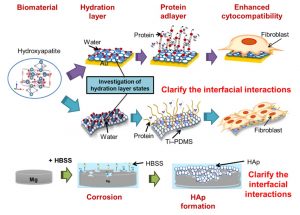

Penaflor Tania
September 2024 – Appointment Assistant Professor, Department of Materials and Life Sciences, Faculty of Science and Technology, Sophia University
2020-2024 – 2020-2024 – National Institute of Technology (Kosen), Nagaoka College (Appointment Assistant Professor) Investigation of the microstructures and mechanical properties of biodegradable magnesium-titanium bonding materials. Teaching innovative and creative problem-solving methods applied to projects related to the SDGs, with a view to promoting Design Thinking, Logical Thinking, and Critical Thinking.
2017-2019 – Nagaoka University of Technology (PhD Course) The research concentrated on the production of Hydroxyapatite nanoparticle films as well as the investigation of the interfacial interactions between the hydration layer and the absorption of proteins for fibroblast adhesion, with a specific focus on their potential applications in the biomedical field.
2014-2015 – Nagaoka University of Technology (Master Double Degree Course) The research project involved the preparation and biological evaluation of nanocrystalline zinc-substituted hydroxyapatite and zinc-substituted carbonate hydroxyapatite films for biomedical applications.
2013-2015 – University of Guanajuato (Master Double Degree Course) The research project concentrated on the synthesis and characterization of highly adsorbent ceramic materials, as well as their evaluation as treatment solutions for tannery waters and other polluted water. In addition to their use as adsorbents for radioactive materials to safely contain radioactive waste.
2011-2013 – University of Guanajuato. Synthesis, and characterization of porous ceramic materials with excellent catalytic properties. In addition to the application of these materials for biodiesel production, lactam synthesis, and hydroxylation reactions.
学士(薬学、生物学、化学)、グアナフアト大学
修士(工学)、 長岡技術科学大学
化学修士、グアナフアト大学
博士(工学)、長岡技術科学大学
Biomaterials, Biocompatibility, Interfacial interactions, Bioinert-Bioactive Composites, Nanoparticles
My research interests lie in the study of interfacial interactions between biomaterials and their surrounding environment. This encompasses a range of phenomena, including the role of hydration layers, protein adsorption, and cell adhesion and spreading, antibacterial activity, and the underlying processes involved. The objective is to gain a deeper understanding of these processes, with the ultimate goal of designing biomaterials that align with the specific requirements of various biomedical applications.
